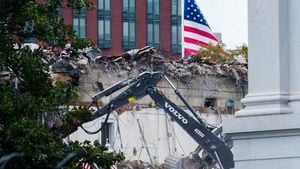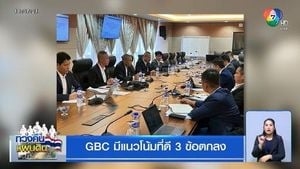On October 22, 2025, the already fragile Gaza ceasefire faced its most severe test yet, as U.S. President Donald Trump issued a blunt warning to Hamas: disarm or face "fast, furious and brutal force." The message, delivered both in a social media post and echoed by Vice President JD Vance during his visit to Israel, marked a dramatic escalation in U.S. pressure on the Palestinian militant group as the next phase of the ceasefire agreement loomed.
"If Hamas doesn’t cooperate, as the president of the United States has said, Hamas is going to be obliterated," Vance declared while meeting Israeli officials in Jerusalem, according to Reuters. The ceasefire, now in its eleventh day, has been repeatedly rattled by violence and mutual accusations of violations between Israel and Hamas. The Gaza health ministry reported that at least 87 Palestinians have been killed by Israeli forces since the truce began, while two Israeli soldiers lost their lives in southern Gaza over the weekend.
Trump’s warning came as the U.S. administration sought to push forward a complex, U.S.-brokered 20-point ceasefire framework, agreed earlier in October in Sharm el-Sheikh, Egypt. The plan not only requires Hamas to disarm but also sets out a path toward the creation of a Palestinian state and the establishment of a technocratic Palestinian committee to govern Gaza—one that would explicitly exclude Hamas from holding power. Instead, the committee would be overseen by an international board, with the Palestinian Authority and other factions involved, according to a Palestinian official close to the talks cited by Reuters.
Despite the high-stakes rhetoric, Vice President Vance struck a more measured tone in meetings with Israeli Prime Minister Benjamin Netanyahu and during press briefings. "We are in a very good place. ...We’re going to have to keep working on it," Vance told reporters, describing the ceasefire as "going better than expected" but cautioning that peace would require "a very, very long time." He declined to set a firm deadline for Hamas’ disarmament, noting, "I don’t think it’s actually advisable to say this has to be done in a week. We don’t yet have the international security force set up."
The U.S. has moved to open a coordination center in Israel, where about 200 American troops are working alongside Israeli and regional partners to manage aid deliveries and lay the groundwork for reconstruction. Jared Kushner, Trump’s son-in-law and former White House adviser, joined Vance at the center and stated that roughly half the bodies of deceased hostages had been recovered, while coordination between Israel and the United Nations on humanitarian aid had been "surprisingly strong." He emphasized that reconstruction would proceed only in areas no longer under Hamas control.
While the U.S. is helping to organize an international stabilization force, Vance was clear: "We’re not going to force anything on our Israeli friends when it comes to foreign troops." Instead, the U.S. will coordinate with regional partners—including Turkey, the Gulf states, and Indonesia—to maintain stability in Gaza. Vance stressed the need for "constant effort, constant monitoring, and supervision," expressing optimism that the ceasefire would hold despite ongoing challenges.
The truce itself remains shaky. Both Israel and Hamas have accused each other of repeated breaches since the ceasefire took effect. Flashes of violence have erupted over the pace of returning hostage bodies, the flow of humanitarian aid, and the opening of border crossings. According to the United Nations World Food Program, aid deliveries have increased through two Israeli-controlled crossings, but supplies still fall far short of the daily target of 2,000 tons, with none reaching northern Gaza as of October 21.
Hamas, for its part, reaffirmed its commitment to the ceasefire during meetings with Turkish officials and mediators in Cairo. The group’s exiled leader, Khalil al-Hayya, told Egyptian television, "Let their [hostages’] bodies return to their families, and let the bodies of our martyrs return to their families to be buried in dignity." Hamas released another hostage body late Monday and pledged to hand over two more, leaving 13 bodies still in Gaza. Israel, meanwhile, returned 15 Palestinian bodies to Gaza on Tuesday, bringing the total to 165, according to local health authorities.
Violence has continued to flare along the so-called "yellow line" demarcating Israel’s military pullback. Israeli troops reportedly killed a person crossing the line on October 21, while Israeli bulldozers began placing yellow concrete blocks to mark the exclusion zone. Palestinians living near the line say it is not clearly marked, making it difficult to know where the danger begins.
The broader context of the conflict remains sobering. Hamas’s October 7, 2023, attack on Israel killed around 1,200 people and resulted in 251 hostages being taken into Gaza, an event that triggered the current war. Since then, the cycle of violence, negotiation, and fragile truces has continued, with each side blaming the other for violations and setbacks.
Trump’s rhetoric has drawn condemnation from human rights organizations, who argue that threats of overwhelming force against a civilian population breach international legal standards. Nonetheless, Trump has insisted that "numerous of our NOW GREAT ALLIES in the Middle East, and areas surrounding the Middle East, have explicitly and strongly, with great enthusiasm, informed me that they would welcome the opportunity, at my request, to go into GAZA with a heavy force and 'straighten out Hamas' if Hamas continues to act badly, in violation of their agreement with us." He added, "I told these countries, and Israel, 'NOT YET!' There is still hope that Hamas will do what is right. If they do not, an end to Hamas will be FAST, FURIOUS, & BRUTAL!"
Meanwhile, Israeli Prime Minister Netanyahu has signaled that the conflict will only "truly end" once Hamas is disarmed, hinting at a possible second phase of the war. Netanyahu also fired his national security adviser, Tzachi Hanegbi, on October 21, reportedly over disagreements about military strategy and the failed attempt to assassinate Hamas leadership in Qatar.
As negotiations continue in Cairo and regional mediators like Egypt, Qatar, and Turkey press for stability, the ultimate fate of the ceasefire—and the future governance of Gaza—remains uncertain. For now, the region stands on a knife’s edge, caught between the hope of lasting peace and the threat of renewed devastation.






